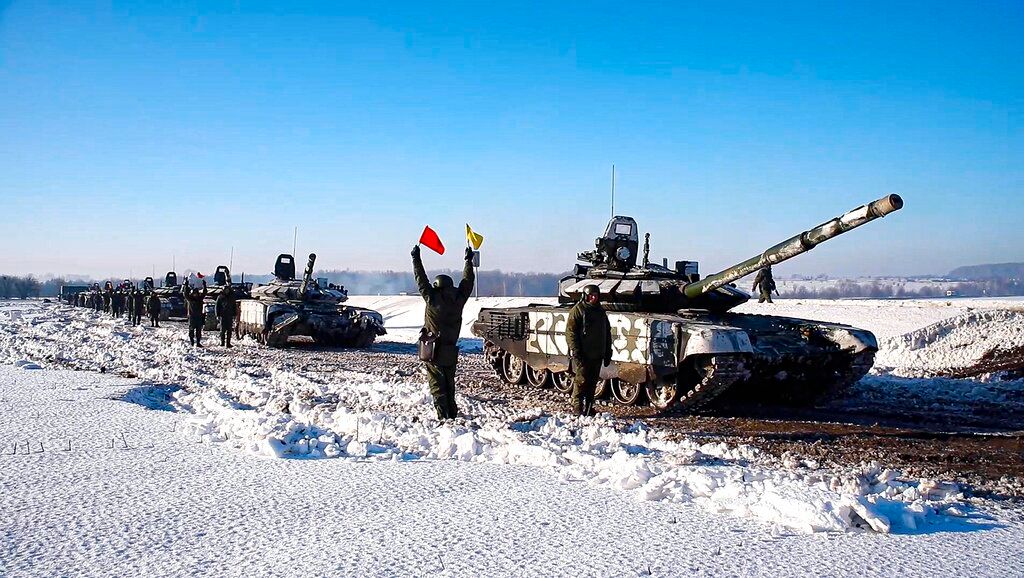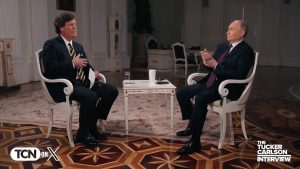In the midst of rising East-West tensions, Russia announced enormous nuclear drills on Friday, while the US delivered some of its harshest, most explicit warnings yet on how a Russian invasion of Ukraine may play out.
A day earlier, US President Joe Biden sounded unusually pessimistic, warning that Washington saw no signs of the promised Russian departure, but instead spotted more troops advancing toward Ukraine’s border.
Also read: Are world leaders afraid to give Putin their DNA? If so, why?
“Every indication we have is they’re prepared to go into Ukraine, attack Ukraine,” Biden told reporters at the White House. He said the U.S. has “reason to believe” that Russia is “engaged in a false flag operation to have an excuse to go in,” but he did not provide details.
Some fear that the long-running separatist conflict in eastern Ukraine will provide exactly that cover. Over the last two days, the area has been subjected to increased bombardment and apparent cyberattacks.
With tensions already at their highest point since the Cold War, Russia’s military announced that President Vladimir Putin will oversee a sweeping exercise of the country’s nuclear forces on Saturday, which will include multiple practise missile launches — a stark reminder of the country’s nuclear might in the midst of the standoff with the West.
Also read: In Ukraine’s volatile east, a day of shelling, outages, fear
Western concerns centre on an estimated 150,000 Russian troops stationed near Ukraine’s borders, accounting for around 60% of Russia’s total field forces. The Kremlin claims it has no plans to invade, but it has long regarded Ukraine as part of its sphere of influence and NATO’s eastward expansion as a threat to its existence. In this situation, Moscow’s main demand is that NATO vow never to allow Ukraine to join, which the Western alliance has flatly rejected.
Biden intended to speak with trans-Atlantic leaders by phone on Friday about Russia’s military buildup and ongoing deterrence and diplomatic efforts.
Secretary of State Antony Blinken of the United States published some intelligence results as part of an attempt to expose and prevent any invasion planning. The US has withheld most of the evidence that supports its accusations.
Blinken informed ambassadors at the United Nations Security Council that the assault would begin with a sudden, supposedly violent event engineered by Russia to justify an invasion.
Also read: Allies watch for Kremlin attempt to justify Russia’s Ukraine invasion
Blinken mentioned a “so-called terrorist bombing” inside Russia, a staged drone strike, “a fake, even a real attack … using chemical weapons.”
Blinken described the arrival of Russian soldiers and their advance on Kyiv, a city of over 3 million people, and other critical targets as beginning with cyberattacks, as well as missile strikes and bombings across Ukraine.
U.S. Defense Secretary Lloyd Austin questioned Russia’s troop withdrawal claims at NATO headquarters in Brussels.
“We’ve seen some of those troops inch closer to that border,” he said. “We even see them stocking up their blood supplies. You don’t do these sort of things for no reason, and you certainly don’t do them if you’re getting ready to pack up and go home.”
Despite the stark U.S. warnings, Ukrainian officials sought to project calm, with Oleksii Danilov, head of the National Security and Defense Council, saying late Thursday that there were no signs a massive Russian invasion was imminent.
Nonetheless, according to a Western person aware with intelligence results, US and European authorities were on high alert for any Russian attempts to construct a pretext for invasion. According to the official, who was not authorised to speak publicly, Ukrainian government officials shared intelligence with allies that suggested the Russians might try to shell areas in the Luhansk region controlled by Moscow-backed separatists on Friday morning in an attempt to create a false reason to take military action.
On Thursday, the area saw a major increase in shelling, with the Organization for Security and Cooperation in Europe reporting more than 500 explosions until tensions abated in the evening. In the nearly 8-year-old conflict in Ukraine’s eastern industrial heartland, known as Donbas, Ukrainian authorities and separatists traded claims of violations of a tenuous cease-fire. The conflict began immediately after Russia annexed the Crimean Peninsula from Ukraine in 2014, and it has claimed the lives of over 14,000 people.
Also read: UK intelligence claims Russia could invade Ukraine without further warning
Shells hit a kindergarten in Stanytsia Luhanska, wounded two adults and knocking out power to half of the town, according to the Ukrainian military command. According to the insurgents, Ukrainian fire damaged roughly 19 homes.
Early Friday, separatist authorities in the Luhansk and Donetsk regions reported more shelling by Ukrainian forces along the tense line of contact.
Ukrainian officials charged that the rebels intensified the shelling in the hopes of provoking a retaliatory attack by government forces.
The Ukrainian military chief, Valerii Zaluzhnyi, said that it’s “not planning any offensive operations or shelling of civilians,” adding that “our actions are purely defensive.”
However, fears that the bloodshed could launch a larger battle continue, prompting Western countries to try to stop or prepare for an invasion.
NATO military ministers reviewed measures to strengthen defences in Eastern Europe, while EU leaders discussed how to respond if Russia invades. Blinken and Vice President Kamala Harris are among the political, military, and diplomatic leaders travelling to Munich for an annual security conference that will include urgent crisis meetings.
Also read: Ukraine crisis: Blinken urges Russia to ‘abandon path of war’ at UNSC
In the next days, the US and Russia will also hold talks. According to the Russian military, Blinken will meet with his Russian counterpart next week, and Russia’s Defense Minister Sergei Shoigu will contact Austin on Friday.
In the face of Western doubts over Russia’s assertion that it’s sending some forces back to bases, Moscow said the pullout would take time. Russia also made a new diplomatic overture Thursday, handing the U.S. a response to offers to engage in talks on limiting missile deployments in Europe, restrictions on military drills and other confidence-building measures.
(with inputs from AP)







